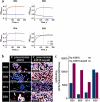Phenotypic whole-cell screening identifies a protective carbohydrate epitope on Klebsiella pneumoniae
- PMID: 34923908
- PMCID: PMC8726669
- DOI: 10.1080/19420862.2021.2006123
Phenotypic whole-cell screening identifies a protective carbohydrate epitope on Klebsiella pneumoniae
Abstract
The increasing global occurrence of recalcitrant multi-drug resistant Klebsiella pneumoniae infections warrants the investigation of alternative therapy options, such as the use of monoclonal antibodies (mAbs). We used a target-agnostic phage display approach to K. pneumoniae bacteria lacking bulky, highly variable surface polysaccharides in order to isolate antibodies targeting conserved epitopes among clinically relevant strains. One antibody population contained a high proportion of unique carbohydrate binders, and biolayer interferometry revealed these antibodies bound to lipopolysaccharide (LPS). Antibodies that bound to O1 and O1/O2 LPS were identified. Antibodies were found to promote opsonophagocytic killing by human monocyte-derived macrophages and clearance of macrophage-associated bacteria when assessed using high-content imaging. One antibody, B39, was found to protect mice in a lethal model of K. pneumoniae pneumonia against both O1 and O2 strains when dosed therapeutically. High-content imaging, western blotting and fluorescence-activated cell sorting were used to determine binding to a collection of clinical K. pneumoniae O1 and O2 strains. The data suggests B39 binds to D-galactan-I and D-galactan-II of the LPS of O1 and O2 strains. Thus, we have discovered an mAb with novel binding and functional activity properties that is a promising candidate for development as a novel biotherapeutic for the treatment and prevention of K. pneumoniae infections.
Keywords: Klebsiella pneumoniae; Phage display; antimicrobial resistance; lipopolysaccharide; monoclonal antibody.
Conflict of interest statement
SR, RM, LI, CC, PW, and DT are current/former employees of the AstraZeneca Group and may have/had stock options in AstraZeneca.
Figures








Similar articles
-
Characterization of mAbs against Klebsiella pneumoniae type 3 fimbriae isolated in a target-independent phage display campaign.Microbiol Spectr. 2024 Aug 6;12(8):e0040024. doi: 10.1128/spectrum.00400-24. Epub 2024 Jun 28. Microbiol Spectr. 2024. PMID: 38940542 Free PMC article.
-
Binding to and opsonophagocytic activity of O-antigen-specific monoclonal antibodies against encapsulated and nonencapsulated Klebsiella pneumoniae serotype O1 strains.Infect Immun. 2000 May;68(5):2402-9. doi: 10.1128/IAI.68.5.2402-2409.2000. Infect Immun. 2000. PMID: 10768923 Free PMC article.
-
Novel, Broadly Reactive Anticapsular Antibodies against Carbapenem-Resistant Klebsiella pneumoniae Protect from Infection.mBio. 2018 Apr 3;9(2):e00091-18. doi: 10.1128/mBio.00091-18. mBio. 2018. PMID: 29615497 Free PMC article.
-
Anti-MrkA Monoclonal Antibodies Reveal Distinct Structural and Antigenic Features of MrkA.PLoS One. 2017 Jan 20;12(1):e0170529. doi: 10.1371/journal.pone.0170529. eCollection 2017. PLoS One. 2017. PMID: 28107434 Free PMC article.
-
Murine monoclonal antibodies to Klebsiella pneumoniae protect against lethal endotoxemia and experimental infection with capsulated K. pneumoniae.Infect Immun. 1990 Sep;58(9):2828-33. doi: 10.1128/iai.58.9.2828-2833.1990. Infect Immun. 1990. PMID: 1696932 Free PMC article.
Cited by
-
Rapid-format recombinant antibody-based methods for the diagnosis of Clostridioides difficile infection: Recent advances and perspectives.Front Microbiol. 2022 Nov 29;13:1043214. doi: 10.3389/fmicb.2022.1043214. eCollection 2022. Front Microbiol. 2022. PMID: 36523835 Free PMC article. Review.
-
Identification of a second glycoform of the clinically prevalent O1 antigen from Klebsiella pneumoniae.Proc Natl Acad Sci U S A. 2023 Jul 18;120(29):e2301302120. doi: 10.1073/pnas.2301302120. Epub 2023 Jul 10. Proc Natl Acad Sci U S A. 2023. PMID: 37428935 Free PMC article.
-
A heptavalent O-antigen bioconjugate vaccine exhibits differential functional antibody responses against diverse Klebsiella pneumoniae isolates.bioRxiv [Preprint]. 2023 Dec 12:2023.12.12.571344. doi: 10.1101/2023.12.12.571344. bioRxiv. 2023. Update in: J Infect Dis. 2024 Sep 23;230(3):578-589. doi: 10.1093/infdis/jiae097. PMID: 38168360 Free PMC article. Updated. Preprint.
-
Heptavalent O-Antigen Bioconjugate Vaccine Exhibiting Differential Functional Antibody Responses Against Diverse Klebsiella pneumoniae Isolates.J Infect Dis. 2024 Sep 23;230(3):578-589. doi: 10.1093/infdis/jiae097. J Infect Dis. 2024. PMID: 38401891 Free PMC article.
-
Klebsiella pneumoniae Lipopolysaccharide as a Vaccine Target and the Role of Antibodies in Protection from Disease.Vaccines (Basel). 2024 Oct 17;12(10):1177. doi: 10.3390/vaccines12101177. Vaccines (Basel). 2024. PMID: 39460343 Free PMC article. Review.
References
-
- Friedlaender C. Ueber die Schizomyceten bei der acuten fibrösen Pneumonie. Arch für Pathol Anat und Physiol und für Klin Med. 1882;87:319–13.
-
- Rock C, Thom KA, Masnick M, Johnson JK, Harris AD, Morgan DJ. Frequency of Klebsiella pneumoniae carbapenemase (KPC)–producing and non-KPC-producing Klebsiella species contamination of healthcare workers and the environment. Infect Control Hosp Epidemiol Off J Soc Hosp Epidemiol Am. 2014;35(4):426. doi:10.1086/675598. - DOI - PMC - PubMed
-
- Lee C-R, Lee JH, Park KS, Jeon JH, Kim YB, Cha C-J, Jeong BC, Lee SH. Antimicrobial resistance of hypervirulent Klebsiella pneumoniae: epidemiology, hypervirulence-associated determinants, and resistance mechanisms. Front Cell Infect Microbiol. 2017;7:483. doi:10.3389/fcimb.2017.00483. - DOI - PMC - PubMed
Publication types
MeSH terms
Substances
LinkOut - more resources
Full Text Sources
